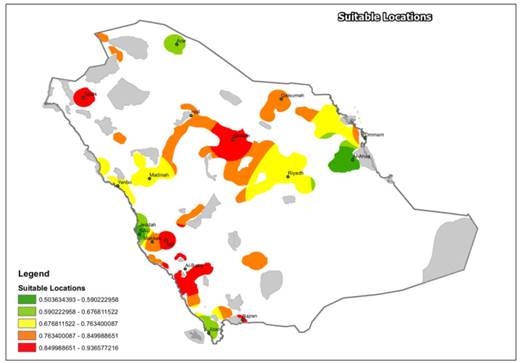– Applying 4 priority criteria and 11 sub-criteria to the optimal solar installation location selection
– The Tabuk area is derived as an optimal location for solar installation
Solar power generation converts light energy from the sun into electrical energy. Saudi Arabia not only has abundant sunlight geographically and environmentally, but also has many attractive factors for solar power generation, such as a large territory and low population density. In this article, I would like to introduce “Optimal Decision-Making in Photovoltaic System Selection in Saudi Arabia” published in the journal energies in January 2021.
In this study, criteria affecting solar system installation were established using Geographical Information System (GIS)-based multi-criteria decision-making, and relative weights were given to each criterion to determine four prioritization criteria and 4 The lower criteria for dogs were presented. After setting the criteria, the matrix was constructed by applying the Analytic Hierarchy Process (AHP).
The advantage of multi-criteria decision making is to set goals and criteria, estimate relative weights, and then determine the contribution of alternatives to individual performance criteria. It is a scientific technique that decomposes the subsequent elements into detailed factors again, compares each attribute, evaluates weights according to their importance, and selects the optimal alternative.
Finally, 17 cities in Saudi Arabia (eg, Riyadh, Jeddah) were evaluated using TOPSIS (Technique for Order of Preference by Similarity to Ideal Solution), which is one of the multi-criteria decision-making techniques. Among the 17 cities, Tabuk, located in northern Saudi Arabia, obtained an 87% performance index and was the best location, and the other 6 cities also showed a performance index of 80% or more.
In most solar installation studies, climate, mountain topography, location, economy, and environment are set as the priority criteria, and the sub-standards are solar irradiation, Average temperature, Relative Humidity, etc. are taken into consideration. Table 1. Items to consider for solar installation are summarized.
In the study being introduced, an optimal region for a solar system was selected in 17 regions of Saudi Arabia by considering 1 priority criteria and 4 sub-criteria suitable for Saudi Arabia among the contents presented in Table 11. Those items are shown in Figure 1. Optimal solar installation location selection. Among the four priority criteria, Climate was based on Solar Irradiation, Average temperature, Relative Humidity, and Dust Storm. Distance to power lines, Distance to main roads, Distance to residential areas, and Population Density were included. For Orography, slope and Aspect angles were used as sub-standards, and Environment included Carbon Emission Reduction.
Table 1. Factors to consider when installing solar power

Figure 1. Four priority criteria and 4 sub-criteria used for optimal solar installation location selection

Figure 2 is a GIS map with 11 sub-criteria applied to Saudi Arabia, and Table 2 is a decision matrix derived by applying 17 sub-criteria to 11 cities. The 2 cities in Table 17 are Abha, Al-Ahsa, Al-Baha, Arar, Dammam, Hail, Jeddah, Jizan, Madinah, Makkah, Najran, Qaisumah, Qassim, Riyadh, Tabuk, Taif and Yenbo. Each of m11 to m1 is indicated, and the unit corresponding to each sub-standard is indicated.
Figure 2. GIS map with 11 sub-criteria applied to Saudi Arabia

Table 2. Decision Matrix

The weights used in the Analytic Hierarchy Process (AHP) are shown in Figure 3. In the case of solar irradiation, a weight of 0.25 was derived as the top priority, Average Temperature was calculated as 0.18, and Population Density and Carbon emission reduction were respectively weighted as 0.02. It appeared as the last factor to consider when installing a photovoltaic system.
Figure 3. GIS map with 11 sub-criteria applied to Saudi Arabia

The final evaluation index is shown in Figure 4. The evaluation index for the optimal location of the solar system in 17 Saudi Arabia regions. The range of the evaluation index is between 0 and 1, and Tabuk is 0.87, which is the optimal location, and Taif, Qassim, Al-Baha, Najran, Abah, and Hail are also 0.8 or more, making it a good area to install a solar system. , Jizan, and Al-Ahsa regions were presented as relatively unsuitable regions with an evaluation index of 0.65 or less. The 17 regional locations are shown in Figure 5. The optimal location map of the solar system in 17 Saudi Arabia regions, and each color is used to express the evaluation index. Red with an evaluation index of 0.8 or higher shows Tabuk, Taif, Qassim, Al-Baha, and Najran regions, and Al-Ahsa with an evaluation index of 0.6 or lower is expressed in green.
Figure 4. Evaluation Index of Optimal Location of Solar System in 17 Regions of Saudi Arabia

Figure 5. Optimal location of solar systems in 17 regions of Saudi Arabia

This article introduced an article on how to determine the optimal location of a solar system in Saudi Arabia. I hope this information will be a reference for those considering solar power projects in Saudi Arabia. For more detailed information, please refer to the energies journal (https://www.mdpi.com/1996-1073/14/2/357) Please refer to



